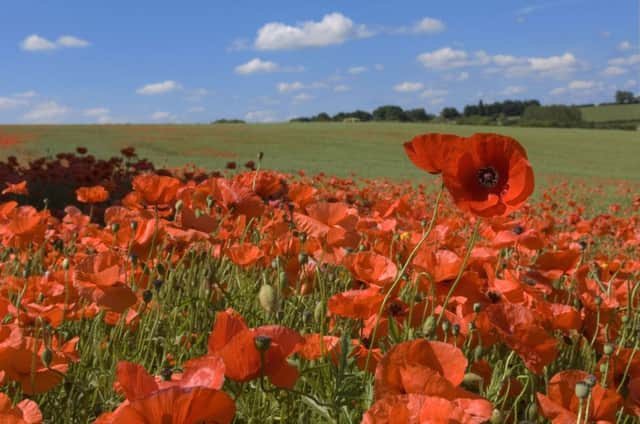Extra time in the garden: Poppy Love


It was a sight which, in 1915, inspired Canadian Lieutenant Colonel John McCrae to write the well-known war poem In Flanders Fields, with poppies growing there ‘row on row’, and as such, this vivid red flower has become synonymous with the great loss of life and sacrifices made in war.
This year, to mark the centenary of the start of the First World War, poppy displays will rightly abound nationwide.
Advertisement
Hide AdAdvertisement
Hide AdThe Royal Botanic Garden Edinburgh is creating a poppy field to be in full bloom in late July, Gunby Hall and Gardens in Lincolnshire has its own poppy trail, and there’s poppy planting at Sheffield Park in East Sussex (www.nationaltrust.org.uk) and beautiful displays at Dyrham Park near Bath.


Poppies will also feature heavily in Birmingham city council’s exhibit in the Great Pavilion at the RHS Chelsea Flower Show this year, while tens of thousands of poppies have also been sown by children, soldiers, civic leaders, community organisations, clergy and faith groups nationwide as a joint act of remembrance.
The field poppy or corn poppy, Papaver rhoeas, is the poppy of wartime remembrance. This annual flower can lie dormant for many years before germination which is then often triggered when the soil is disturbed. It’s perfect planted in a sunny wildflower garden or a meadow where it will self-seed freely.
Throughout history, a new generation of corn poppies was germinated each year as land was ploughed and grain scattered. It is a plant relevant to many cultures — to the Egyptians it symbolised blood and rebirth, while the Romans hailed it as the sacred crop of Ceres.
Advertisement
Hide AdAdvertisement
Hide AdIts family, papaveraceae, is relatively small, with less than 800 species, but the types vary greatly in size and colour. Among the largest are the flowers of P. orientale Goliath Group, appearing atop shoulder-high stems. The petals share the same tissue-paper look as their smaller cousins, yet poppy types range from the toughest hardy perennials to pretty annuals, from giants with tall spires such as P. pilosum, to ground-hugging alpines. They are all followed by round decorative seedpods.


By far the most showy and most familiar in the garden is Papaver orientale, which adds dramatic highlights to early summer with their spectacular blooms. The typical oriental poppy is a hardy perennial which produces scarlet flowers with a black blotch at the bottom of each petal, but you can get other colours including pink, orange, white and plum. Stunning varieties include Mrs Perry, with large salmon-pink blooms and Patty’s Plum, which is dark and dramatic.
Most named oriental poppies are sterile and can be propagated by root cuttings, while species poppies rely on seed to keep them going. P. somniferum, the opium poppy enjoyed for its ornamental value, is a prolific self-seeder, but it’s best to save some of its seeds to sow where you actually want them to be.
All poppies have a dainty appearance but many don’t need staking. However, you must remove the dead blooms to prolong the flowering season. Good companions to oriental poppies include the frothy flowers of Gypsophila paniculata, penstemon and agapanthus.
Advertisement
Hide AdAdvertisement
Hide AdMost poppies prefer sun and moist soil but several, including the Welsh poppy, Meconopsis cambrica, prefer stretches of woodland in dappled shade, where they colonise ground between bluebells and wood anemones.
So while the field poppy will always remain one of the most powerful and poignant images of remembrance, its wider family in all its glorious colours and forms has earned itself a well-deserved place in the British garden.